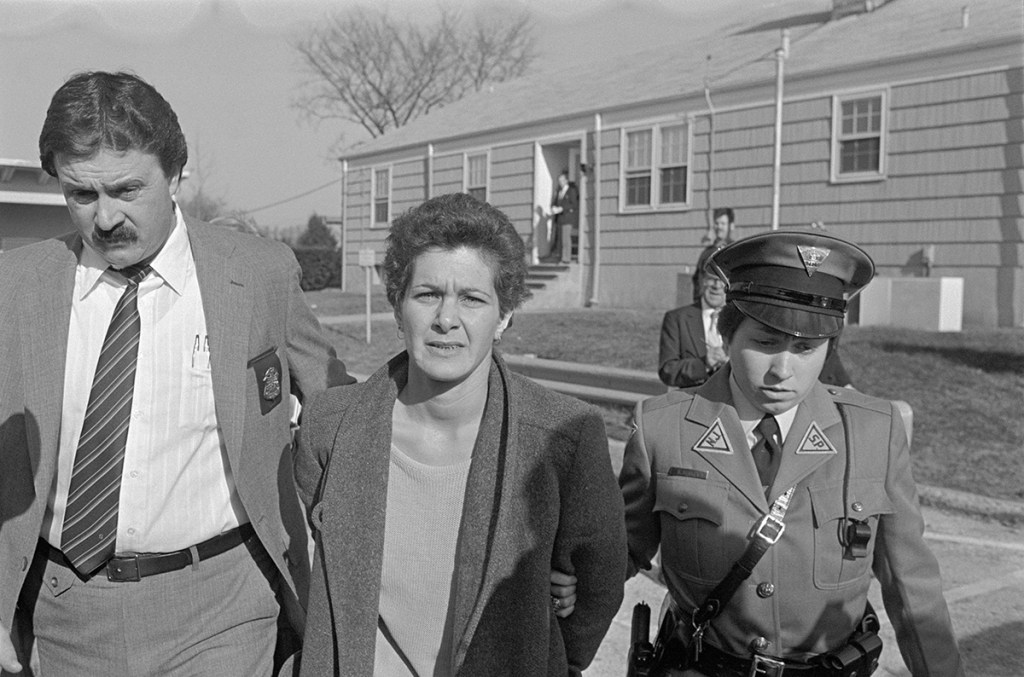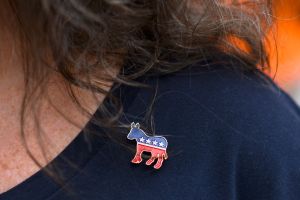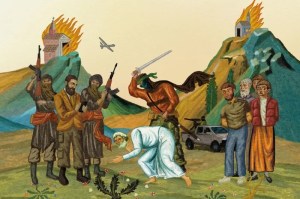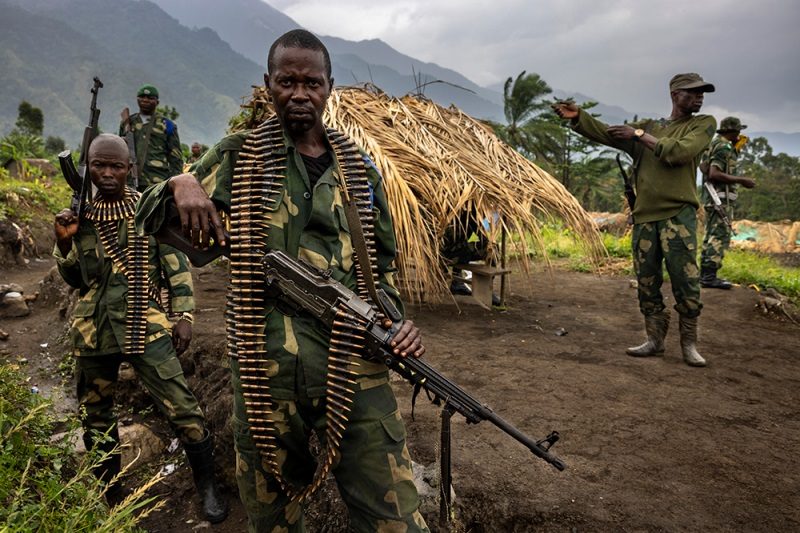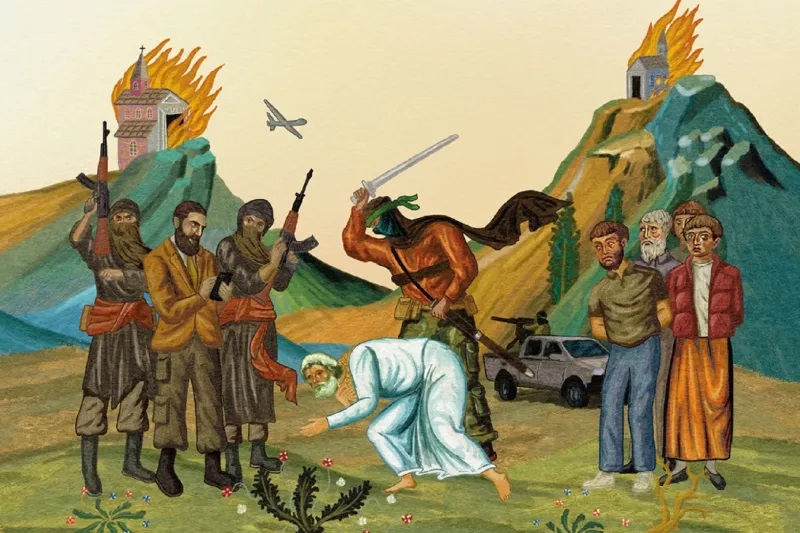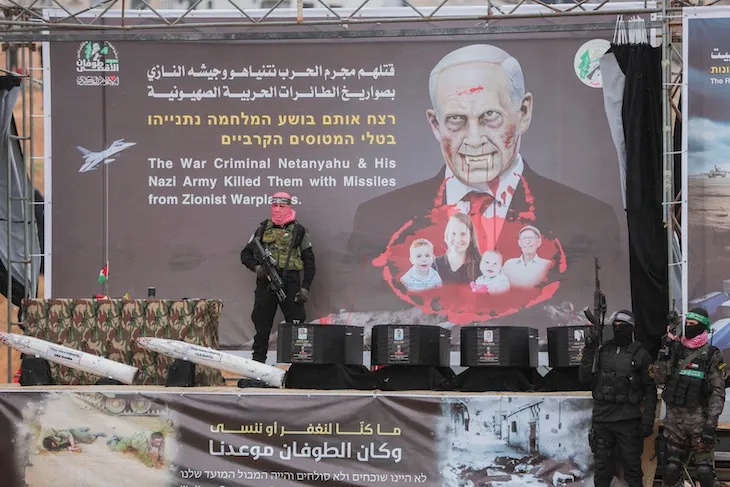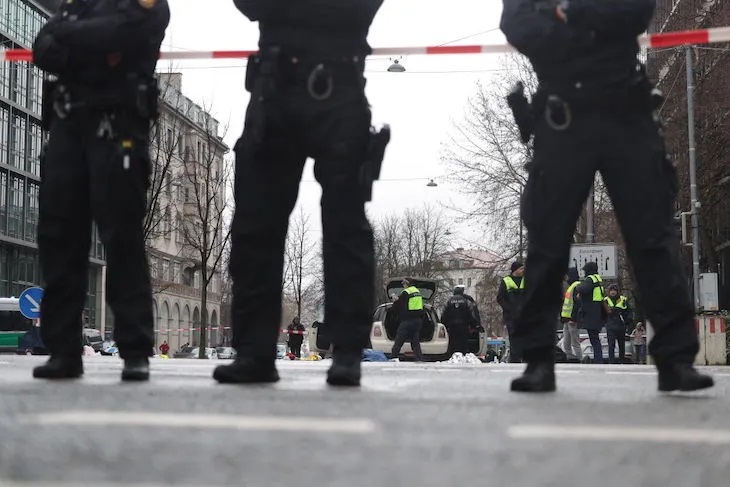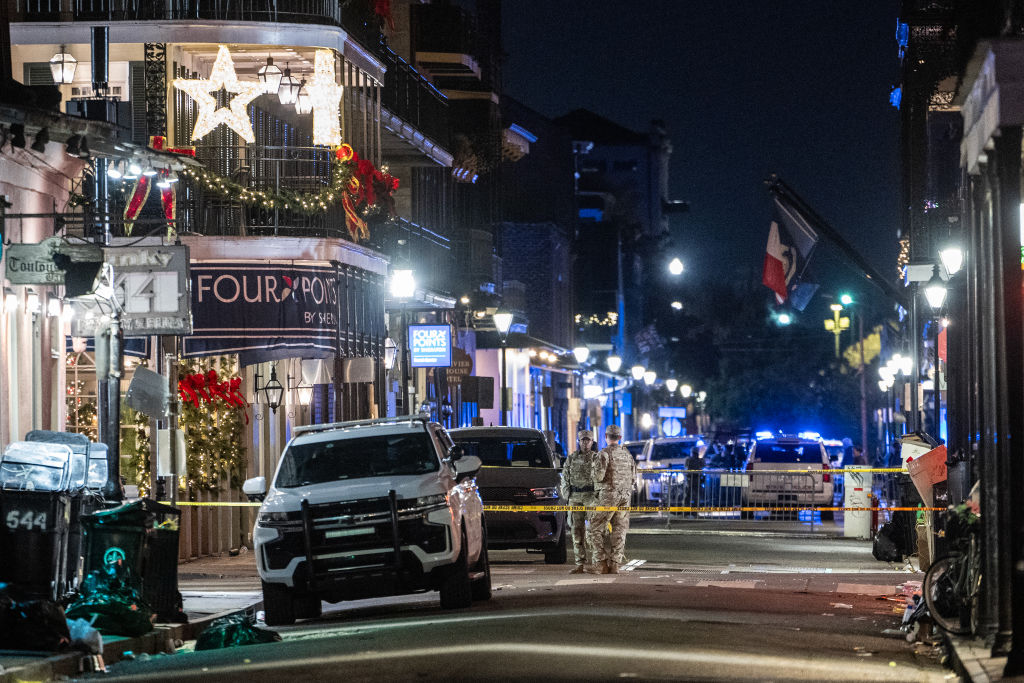Late on the afternoon of November 29, 1984, Susan Rosenberg and Timothy Blunk were loading boxes into a blue Oldsmobile Cutlass sedan and a U-Haul trailer parked at a self-storage facility in Cherry Hill, New Jersey, not far from Philadelphia. The boxes were heavy, so despite the autumn chill and the wind, Rosenberg and Blunk were working up a sweat. Both wore glasses as part of their disguises. Blunk had an ill-fitting wig that he barely managed to keep on his head.
An FBI wanted poster called Rosenberg armed and extremely dangerous, and the Bureau wasn’t wrong. On the front seat of the Olds, purses held semiautomatic pistols — an Interarms Walther PPK .38 caliber and a Browning Hi-Power 9mm. They were both fully loaded.
A Cherry Hill policeman, Mark DeFrancisco, pulled up at 5:52 p.m. The facility’s night manager had called, reporting suspicious goings-on. Moving towards the pair, the policeman asked to see identification. Blunk’s driver’s license said he was William J. Hammond. Rosenberg then handed over hers.
DeFrancisco asked her what her birth date was. Her answer didn’t match the license. DeFrancisco asked if she had any other identification. Maybe it was just a simple mistake. Rosenberg told him she could go back to her car and get another ID. DeFrancisco said no: ‘Something told me I’d better not let her get to the car,’ he recalled.
Officer Craig Martin arrived as backup. Inside the trailer and locker, the patrolmen found what the press would call a ‘terror arsenal’: an Action Arms 9mm semi-automatic Uzi, complete with replacement barrels; hundreds of rounds of ammunition; sawed-off shotguns; rifles; a Sturm Ruger .357 magnum revolver with its serial number filed off. And lots of paper: weapons manuals; hundreds of fake FBI, Drug Enforcement Administration and state police IDs; 10,250 phony Social Security card blanks. Before long, Rosenberg and Blunk were in handcuffs.
One cop lit a cigarette. ‘Put out the fucking cigarette,’ Rosenberg said. The patrolman quickly got the point. She and Blunk had been trying to move 740lb of explosives, including 199 sticks of Hercules Unigel Tamptite dynamite and 110 cartridges of DuPont Tovex 210 water-gel explosives, plus electric blasting caps, detonating cord, and Hercules Slurry Hp-374, a blasting agent. They called it ‘combat material’.
The dynamite was in horrible shape. You were supposed to rotate the sticks every 30 days, but somebody hadn’t been doing their job, and the dynamite was breaking down. Nitroglycerin was oozing from the cylinders — ‘weeping’, in technical parlance. A stray spark could have set off a terrifying blast.
Bureau of Alcohol, Tobacco, and Firearms agents and cops from the Philadelphia bomb squad were called in to recover the stuff. They piled up the dynamite and the other material, but then realized they would have to divide it up before hauling it over the Ben Franklin Bridge to the disposal site in Philadelphia. The explosives were unstable, and if they moved it all together, it might have detonated and dropped the bridge, or taken out a city block. Indeed, at the federal trial of Rosenberg and Blunk the following year, the judge compared the explosive potential of their storage locker load to the truck bomb in Beirut that had flattened a four-story military barracks and killed 241 US military personnel in 1983.
Rosenberg and Blunk, self-described ‘revolutionary anti-imperialists’, were part of a terrorist formation called the May 19th Communist Organization. Founded by radical women in 1978, May 19th was named after the birthday shared by two of their idols, Malcolm X and Ho Chi Minh. Between 1979 and 1985, May 19th robbed banks and armored trucks, participated in audacious prison breaks, and bombed targets in New York City and Washington, DC. It had several hundred members, most of whom operated openly or as part of May 19th-controlled front groups. The inner circle responsible for the group’s violent action was tiny, numbering perhaps a dozen people at the most.
Although many people associate left-wing terrorism with the 1960s, the following decade was far more violent. In 1974 alone, there were 2,044 bombings in America, with 24 people killed. Violent extremist groups dotted the political landscape in a way they simply do not today.
In the era of Donald Trump, peddlers of conventional wisdom would have us believe that our rambunctious republic has entered a period of unprecedented national polarization. As the Washington Post’s Dan Balz intoned, ‘This country goes into 2020 as divided as it’s ever been.’
This is nonsense. We hear a lot of talk about the ‘alt-right’ and ‘normalization’ of white supremacy in American life. Yet we barely pause to consider that, not so long ago, revolutionary domestic terrorists were killing men and women for ideological reasons. It’s an odd quirk of our society that these figures are now considered quaint bygones when many are still alive today. Worse, murderous people have been given a left-wing glamour because they are seen as on the right side of history, fighting the good fight for racial justice or feminism.
May 19th is a case in point. Some of its key members were veterans of the Weather Underground Organization, a group that emerged from the ashes of Students for a Democratic Society, the nation’s largest anti-Vietnam War group. Weather described its raison d’être in a 1974 manifesto: ‘to disrupt the empire…to incapacitate it, to put pressure on the cracks.’ The group was responsible for scores of bombings of government buildings and other targets (including an accidental one, when members destroyed a Greenwich Village townhouse and killed three of their own with a bomb intended for a US Army noncommissioned officers’ dance at Fort Dix, New Jersey).
In New York, the Bay Area of California and other parts of America, the Black Liberation Army, an offshoot of the Black Panthers, assassinated at least 15 policemen. Two of the most notorious of these murders took place on May 21, 1971, when New York Police Department officers Joseph Piagentini and Waverly Jones responded to a call from a public housing complex beneath Coogan’s Bluff in Upper Manhattan. Three BLA gunmen — Herman Bell, Anthony Bottom and Albert ‘Nuh’ Washington — ambushed them. Rounds smashed in Jones’s head and back, killing him almost instantly. The BLA men took their time with Piagentini, slowly firing 22 rounds into his body.
The Fuerzas Armadas de Liberación (FALN), a group fighting for Puerto Rican independence and the creation of a Castro-style state on the island, was responsible for more than 100 bombings, including an August 3, 1977 attack on the Mobil Oil headquarters in Midtown Manhattan that killed one office worker and severely injured others. Their most infamous operation took place Downtown in the financial district. On January 24, 1975, the FALN planted a bomb inside Fraunces Tavern. The place was drenched in American history — General George Washington had bidden farewell to his officers there in 1783. At 1:29 p.m., during the lunch service, the device went off, killing four people and wounding sixty more.
The United Federated Forces of the Symbionese Liberation Army, or SLA, was led by an escaped convict who adopted the nom de guerre ‘Field Marshal Cinque Mtume’. Their slogan: ‘Death to the fascist insect that preys upon the life of the people.’ The SLA robbed banks, kidnapped newspaper heiress Patty Hearst (aka ‘Tania’), murdered Marcus Foster, a distinguished educator and the first African American to run a major US school system, and came close to killing his deputy, Robert Blackburn. Mtume committed suicide the following year in Los Angeles during one of the largest police shootouts in American history.
Even further out on the fringe was Tribal Thumb, led by a charismatic ex-con who peddled a bizarre ideological home-brew that blended revolutionary socialism with Reichean sexual psychology. Its ranch in tiny Honeydew, California, in the remote northern reaches of the state, attracted recruits from the SLA and BLA, and members of Charles Manson’s murderous ‘Family.’ Sara Jane Moore, the would-be assassin who popped off a round at President Ford on September 22, 1975, reportedly used the Honeydew ranch to practice her marksmanship.
By the late 1970s, violent left-wing extremism was disappearing. Comrades were dead, in jail, on the run, or had simply left revolutionary politics and re-entered conventional American life. May 19th vowed to continue the armed struggle against the rampaging American imperialist monster.
During the group’s first years, members joined forces with Mutulu ‘Doc’ Shakur, a Harlem acupuncturist and future stepfather of hip-hop great Tupac Shakur. Doc was eager to raise funds for the Republic of New Afrika, a pan-African revolutionary movement trying to carve out a black homeland in the Deep South. Shakur and his crew of gun-wielding African-American militants saw banks and armored cars as key revenue sources, and enlisted May 19th women to procure weapons, conduct surveillance, rent and drive getaway cars. The alliance paid rich dividends: by the middle of 1981, they had stolen nearly $1 million.
May 19th also joined forces with the FALN. On July 12, 1978, FALN bombmaker-in-chief Willie Morales was in his seedy apartment in Queens, New York doing what he loved most. As he was putting the finishing touches to an improvised explosive device, it detonated accidentally, and blew off nine fingers and half of his face. In May the following year, Morales was languishing in the prison ward on the third floor of New York’s Bellevue hospital and waiting to be fitted with a pair of artificial hands.
The FALN wanted him out of there, and May 19th women, along with some of Shakur’s crew, agreed to help. Morales’s lawyer, who was closely linked with May 19th, allegedly smuggled in a pair of bolt cutters. On the evening of May 21, 1979, Willie got down to business. Using his stumps to work the strapped-on bolt cutters, he snipped through the thin wire mesh covering the window in his cell and somehow managed to shimmy down a rope improvised from Ace bandages. Comrades took him to a May 19th safe house in East Orange, New Jersey. Morales made his way to Cuba, where Fidel Castro granted him political asylum, and where he remains to this day. The FBI still wants him back, and is offering a $100,000 reward for information leading to his arrest.
The partnership between Doc and the May 19th women came to an end in the aftermath of a bloody, botched armored-car job in the New York suburbs on October 20, 1981 that left two policemen and a Brink’s guard dead. Judith Clark, a May 19th member who served as a getaway driver, was arrested after she crashed the car not far from the robbery scene. Convicted on three counts of second-degree murder, Clark had her sentence commuted by New York Governor Andrew Cuomo in late 2016, making her eligible for parole. On May 10, 2019, she walked free after spending 37 years behind bars.
The Brink’s robbery brought May 19th to the attention of the FBI. And the press feasted. Rupert Murdoch’s New York Post published a richly lurid series on the group, describing them as ‘a hard-nosed matriarchy dominated by lesbians’, and recounting in titillating detail life inside May 19th collectives.
A nationwide hunt was on for anyone potentially connected to the robbery. But, despite the dangers, for the professional revolutionaries of May 19th, continuing the armed struggle was irresistible. ‘We need to be able to respond to the offensives of Third World struggles by an offensive of our own,’ declared their manifesto. Bombings would be wake-up calls for the imperialists, warmongers and racists. Having stolen 10 50lb boxes of dynamite from a building site in Austin, Texas back in 1980, they had plenty of material for making bombs.
On January 28, 1983, they bombed a small FBI office in Staten Island. Over the next two years, using a number of ferocious-sounding noms de guerre (‘Red Guerrilla Resistance’, ‘Armed Resistance Unit’) May 19th went on to bomb the South African consulate and a police union headquarters in Manhattan, the National War College at Fort McNair in Washington, DC, the Washington Navy Yard and, on the night of November 7, 1983, the US Capitol building.
None of these attacks killed anyone. But May 19th contemplated the use of lethal violence. In a communiqué issued after the Capitol bombing, the group announced that ‘We purposely aimed our attack at the institutions of imperialist rule rather than at individual members of the ruling class and government. We did not choose to kill any of them at this time. But their lives are not sacred and their hands are stained with the blood of millions.’ Later, in a paper circulated within May 19th, one member wrote that the group needed to ‘transform ourselves from target shooters to combat shooters’, adding that ‘investigative work showed the possibility of doing an action that could possibly eradicate several high ranking officers’. The paper had an ominous conclusion: ‘We believe that selective assassination of very clear targets is on the agenda now.’
And what about the ‘terror arsenal’ discovered in New Jersey, and the second stockpile of high explosives, automatic weapons and ammunition found in Doylestown, Pennsylvania in May 1985? It seems fair to conclude that May 19th was preparing for some kind of war.
Most of its inner circle received long prison sentences for conspiracy, weapons and explosives charges, and other offenses. On President Bill Clinton’s last day in office, he dispensed pardons to an assortment of tarnished and tawdry figures, including Marc Rich, the rogue commodities trader; Roger Clinton, the president’s own coke-dealing half-brother; Patty Hearst of SLA fame; and Susan Rosenberg and another May 19th member, Linda Sue Evans. Betty Ann Duke, a Texas-born member of May 19th inner circle, jumped bail in 1985, and remains at large. Timothy Blunk, after spending a decade in high-security federal prisons, is a New Jersey florist and part-time saxophonist.
So next time you hear somebody saying, because of some viral video of a clash between ‘antifa’ activists and men in MAGA hats, that America is tearing itself apart, tell them about May 19th. Americans have a remarkable ability to forget the restlessness of our history. We had a civil war, when the country cracked up and went to war with itself over slavery. The terrorism of the 1970s and early 1980s, while hardly on the scale of the 1860s in terms of violence and polarization, took place in another period of intense national discord. As Gore Vidal, managing to stumble on the truth, once pointed out, we live in the ‘United States of Amnesia’.



